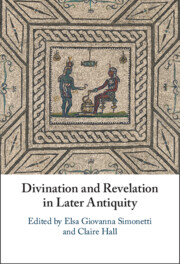Book contents
- Divination and Revelation in Later Antiquity
- Divination and Revelation in Later Antiquity
- Copyright page
- Contents
- Illustrations
- Notes on Contributors
- Acknowledgements
- Introduction
- Part I Philosophical Perspectives on Divination, Revelation, and Prophecy
- Part II Status, Role, and Functions of Human Intermediaries
- Chapter 5 ‘The Holiest Man Ever Born’: Sages, Theioi Andres, and the Shaping of Late Greek Prophecy
- Chapter 6 Women and Divine Dreams in Jewish Texts of the Greco-Roman Era
- Chapter 7 Epiphany and Divination Reconsidered
- Chapter 8 The True Prophet in the Pseudo-Clementine Homilies
- Part III Divine Transcendence and Pragmatic Purposes
- Index
- References
Chapter 6 - Women and Divine Dreams in Jewish Texts of the Greco-Roman Era
from Part II - Status, Role, and Functions of Human Intermediaries
Published online by Cambridge University Press: 19 October 2023
- Divination and Revelation in Later Antiquity
- Divination and Revelation in Later Antiquity
- Copyright page
- Contents
- Illustrations
- Notes on Contributors
- Acknowledgements
- Introduction
- Part I Philosophical Perspectives on Divination, Revelation, and Prophecy
- Part II Status, Role, and Functions of Human Intermediaries
- Chapter 5 ‘The Holiest Man Ever Born’: Sages, Theioi Andres, and the Shaping of Late Greek Prophecy
- Chapter 6 Women and Divine Dreams in Jewish Texts of the Greco-Roman Era
- Chapter 7 Epiphany and Divination Reconsidered
- Chapter 8 The True Prophet in the Pseudo-Clementine Homilies
- Part III Divine Transcendence and Pragmatic Purposes
- Index
- References
Summary
This article analyzes women’s access to divine dreams in the Jewish texts of the Greco-Roman era: the Jubilees, the Liber antiquitatum biblicarum, the Jewish War, Jewish Antiquities, and Against Apion. By evaluating women’s dreams in light of anthropological understanding of divine dreams, that is, dreams that somehow claim to have a divine origin, this chapter aims to offer a new model for understanding women’s dreams in ancient Jewish texts. It is argued that while the preserved literature includes only a few dreams experienced by women, these examples nonetheless provide essential evidence of women being recipients of divine information in ancient Jewish texts.
- Type
- Chapter
- Information
- Divination and Revelation in Later Antiquity , pp. 120 - 135Publisher: Cambridge University PressPrint publication year: 2023



